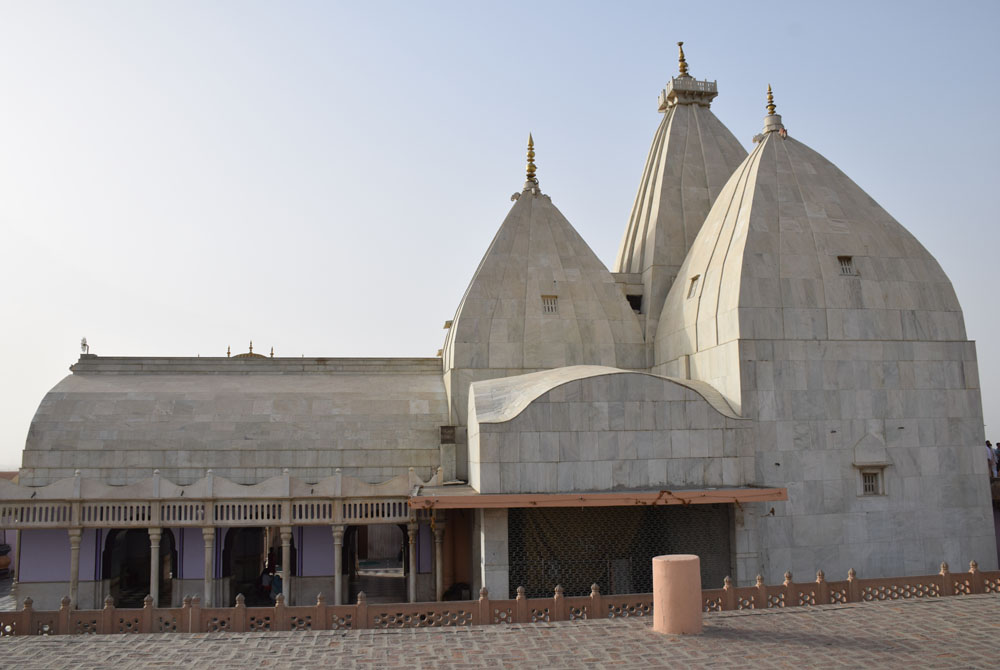
This is the village where Krishna lived with His so-called ‘foster parents’, Yashoda Mayi and Nanda Maharaja. After leaving Gokula because of the disturbance created by the demons, Nanda Maharaja first stayed at Shakatikara (Chhatikara), and then at Dig and then at Kamyavana, and finally settled at Nandagrama. Here he built a permanent residence. It is said that Krishna was in His sixth year when Nanda and Yashoda arrived at Nandagrama. He remained there until He was almost eleven, when He left to reside in Mathura with His actual parents, Vasudeva and Devaki to whom He was born in the prison cell of Kamsa.
In the Bhaktivedanta purports to the Srimad Bhagavatam, it is mentioned that Nanda Maharaja left Gokula when Krishna was three years and four months old, having more or less completed His ‘kaumara-lila’.
At Shakatikara, Krishna enjoyed His ‘pauganda-lila’ and began taking out the calves along with other cowherd boys of the same age. Krishna celebrated His fifth birthday at Shakatikara. After few more months, Nanda Maharaja left Shakatikara and after staying at a few places such as Dig and Kamyavana, and finally settled at Nandagrama when Krishna was six years and eight months old. At Nandagrama, Krishna entered His purva-raga and assumed the beauty of a million cupids which marks the beginning of the period of His ‘kaisora-lila’. In this period, Krishna looks after the cows instead of the calves and begins His amorous pastimes with the gopis. Then at the age of ten years and seven months, Krishna left Nandagrama for Mathura. Nanda Maharaja, who was the king of the cowherd men, built his palace known as Nanda Bhavana, on top of the hill known as Nandishwara Parvata and the cowherd men built their houses around it.
Nandagrama means the village or ‘grama’ established by Nanda. The hill on which Nanda Baba’s palace was built known as Nandishvara Parvata and is said to be an expansion of Lord Shiva. Nandishwara is the name of Lord Shiva meaning that Shiva is the Lord of Nandi, the famous bull carrier of Lord Shiva. The story of this hill is mentioned in the Puranas. Once Lord Shiva, after having undergone penance for a very long time, prayed to Krishna to be allowed the opportunity to witness His transcendental pastimes, by taking the form of a hill in Vrindavana. Lord Shiva was hoping that Krishna and the gopis would walk on top of him and he could receive the dust of their lotus feet on his head. Having heard Shiva’s request, Krishna agreed to his proposal and told Lord Shiva to appear as a hill in the vicinity of Nandagrama, where in the Dwarapa-yuga, He would perform His kaishora-lila pastimes. Therefore, Lord Shiva manifested himself here as the hill which became known as Nandishwara Parvata.
In the Bhakti-ratnakara it says, “O Srinivasa, see the home of Nanda Maharaja called Nandishwara. Disguised as human beings, Krishna and Balarama enjoyed Their pastimes here. See here the boundary of Nanda Maharaja’s residence. To the east of Nanda Bhavana is a wonderful garden. Coming from Yavat, Radharani would come here with Her friends.”
Nandagrama has a parikrama of six kilometers which includes many places of interest. During Krishna’s pastimes there were at least fifty-six important kundas scattered around the sacred village. But in course of time, many have now disappeared. It is said that the father of Nanda Maharaja, Parjanya Maharaja, previously lived near Tagada-tirtha, which is not far from Nandishwara Parvata. Unfortunately, because of Kesi demon terrrorizing the entire area, Parjanya was forced to move his residence to Mahavana and eventually established a cowherd community at Gokula, on the eastern bank of the Yamuna.
Parjanya, Nanda’s father, was the son of King Devamidha of the Bhoja Dynasty. He was born from the king’s second wife who was of gopi decent; therefore, Parjanya became a gopa and was king of the cowherd men. Parjanya’s brother Maharaja Surasena was born from the first wife of Devamidha who was of ksatriya decent, and so he became a ksatriya king and ruled over the province of Surasena and later became the father of Vasudeva, Krishna’s father. Thus, Nanda and Vasudeva were related as cousins, having been born from the two brothers Parjanya and Surasena. The Bhojas were part of the celebrated Yadava dynasty descended from Maharaja Yadu, the son of Emperor Yayati.
Nandagrama is mentioned to be one of the upavanas or sub-forests of Vrindavana. The village of Nandagrama is also considered to be within the boundaries of Vrindavana forest itself, which according to various Puranas, encompasses an area stretching from Sevakunja to Nandagrama and covers the entire western bank of the Yamuna. Therefore in the tenth-canto of Shrimad Bhagavatam, it is often said that Krishna was returning to Vrindavana in the evening with his cows, even though he was actually returning to Nandagrama. In the Brihad-gautamiya-tantra it says. “The forest of Vrindavana consists of five yojanas.” Five yojanas is equal to forty miles which is the straight-line distance from Vrindavana to Nandagrama. The Bhagawata Purana says. “Between Nandeshwara and Mahavana is a place named Vrindavana.” The Skanda Purana says “Oh, the abode of Vrindavana where Govardhana hill is situated.” These verses confirm that Vrindavana covers the area from the border of Mahavana northwards to Nandagrama and also includes Radha-kunda, Govardhana Hill, and Varsana. This particular region is also specifically referred as the heart or inner-core of Vraja, and is also famously known as Nanda’s Vraja, and is the region where Krishna spent most of His life and where He performed most of his prominent pastimes. This same area from Seva Kunja to Nandagrama, corresponds exactly to the northern petal of the lotus of Vraja and also includes; Kelanvana, Rama Ghata, Akshaya Vata, Chira Ghata, Nanda Ghata, Vatsavana and Vatsa-krida.